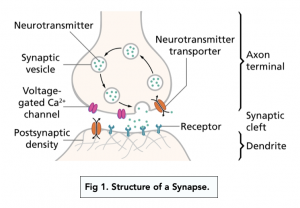The Structure of the Synapse (A-level Biology)
The Structure of the Synapse
Synapses
Types of Synapse
Neurones are separated by junctions called synapses, which allow an electrical impulse to continue from one neurone to the next.
There are two main types of synapse:
-
- Electrical synapses – if the gap between the two neurones is small enough, the electrical impulse can pass directly across through intercellular connections called gap junctions.
-
- Chemical synapses – if the gap between two neurones is too large for the electrical impulse to pass directly across, chemical synapses occur. These use chemicals known as neurotransmitters to transmit the information across.
Parts of a Synapse
- The synaptic knob is the end of the presynaptic neurone that contains vesicles of neurotransmitters.
- When an impulse reaches the knob, the neurotransmitters diffuse across the synaptic cleft (the gap between the neurones) and bind to receptors on the post-synaptic membrane, triggering an impulse in the next neurone.






Still got a question? Leave a comment
Leave a comment